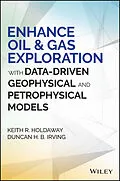Leverage Big Data analytics methodologies to add value to geophysical and petrophysical exploration data
Enhance Oil & Gas Exploration with Data-Driven Geophysical and Petrophysical Models demonstrates a new approach to geophysics and petrophysics data analysis using the latest methods drawn from Big Data. Written by two geophysicists with a combined 30 years in the industry, this book shows you how to leverage continually maturing computational intelligence to gain deeper insight from specific exploration data. Case studies illustrate the value propositions of this alternative analytical workflow, and in-depth discussion addresses the many Big Data issues in geophysics and petrophysics. From data collection and context through real-world everyday applications, this book provides an essential resource for anyone involved in oil and gas exploration.
Recent and continual advances in machine learning are driving a rapid increase in empirical modeling capabilities. This book shows you how these new tools and methodologies can enhance geophysical and petrophysical data analysis, increasing the value of your exploration data.
* Apply data-driven modeling concepts in a geophysical and petrophysical context
* Learn how to get more information out of models and simulations
* Add value to everyday tasks with the appropriate Big Data application
* Adjust methodology to suit diverse geophysical and petrophysical contexts
Data-driven modeling focuses on analyzing the total data within a system, with the goal of uncovering connections between input and output without definitive knowledge of the system's physical behavior. This multi-faceted approach pushes the boundaries of conventional modeling, and brings diverse fields of study together to apply new information and technology in new and more valuable ways. Enhance Oil & Gas Exploration with Data-Driven Geophysical and Petrophysical Models takes you beyond traditional deterministic interpretation to the future of exploration data analysis.
Autorentext
KEITH R. HOLDAWAY is advisory industry consultant and principal solutions architect at SAS. He holds seven patents and is the author of Harness Oil and Gas Big Data with Analytics.
DUNCAN H. B. IRVING is a practice partner for oil and gas consulting at Teradata. He publishes regularly on big data analytics applied to the upstream domain.
Inhalt
Foreword xv
Preface xxi
Acknowledgments xxiii
Chapter 1 Introduction to Data-Driven Concepts 1
Introduction 2
Current Approaches 2
Is There a Crisis in Geophysical and Petrophysical Analysis? 3
Applying an Analytical Approach 4
What Are Analytics and Data Science? 5
Meanwhile, Back in the Oil Industry 8
How Do I Do Analytics and Data Science? 10
What Are the Constituent Parts of an Upstream Data Science Team? 13
A Data-Driven Study Timeline 15
What Is Data Engineering? 18
A Workflow for Getting Started 19
Is It Induction or Deduction? 30
References 32
Chapter 2 Data-Driven Analytical Methods Used in E&P 34
Introduction 35
Spatial Datasets 36
Temporal Datasets 37
Soft Computing Techniques 39
Data Mining Nomenclature 40
Decision Trees 43
Rules-Based Methods 44
Regression 45
Classification Tasks 45
Ensemble Methodology 48
Partial Least Squares 50
Traditional Neural Networks: The Details 51
Simple Neural Networks 54
Random Forests 59
Gradient Boosting 60
Gradient Descent 60
Factorized Machine Learning 62
Evolutionary Computing and Genetic Algorithms 62
Artificial Intelligence: Machine and Deep Learning 64
References 65
Chapter 3 Advanced Geophysical and Petrophysical Methodologies 68
Introduction 69
Advanced Geophysical Methodologies 69
How Many Clusters? 70
Case Study: North Sea Mature Reservoir Synopsis 72
Case Study: Working with Passive Seismic Data 74
Advanced Petrophysical Methodologies 78
Well Logging and Petrophysical Data Types 78
Data Collection and Data Quality 82
What Does Well Logging Data Tell Us? 84
Stratigraphic Information 86
Integration with Stratigraphic Data 87
Extracting Useful Information from Well Reports 89
Integration with Other Well Information 90
Integration with Other Technical Domains at the Well Level 90
Fundamental Insights 92
Feature Engineering in Well Logs 95
Toward Machine Learning 98
Use Cases 98
Concluding Remarks 99
References 99
Chapter 4 Continuous Monitoring 102
Introduction 103
Continuous Monitoring in the Reservoir 104
Machine Learning Techniques for Temporal Data 105
Spatiotemporal Perspectives 106
Time Series Analysis 107
Advanced Time Series Prediction 108
Production Gap Analysis 112
Digital Signal Processing Theory 117
Hydraulic Fracture Monitoring and Mapping 117
Completions Evaluation 118
Reservoir Monitoring: Real-Time Data Quality 119
Distributed Acoustic Sensing 122
Distributed Temperature Sensing 123
Case Study: Time Series to Optimize Hydraulic Fracture Strategy 129
Reservoir Characterization and Tukey Diagrams 131
References 138
Chapter 5 Seismic Reservoir Characterization 140
Introduction 141
Seismic Reservoir Characterization: Key Parameters 141
Principal Component Analysis 146
Self-Organizing Maps 146
Modular Artificial Neural Networks 147
Wavelet Analysis 148
Wavelet Scalograms 157
Spectral Decomposition 159
First Arrivals 160
Noise Suppression 161
References 171
Chapter 6 Seismic Attribute Analysis 174
Introduction 175
Types of Seismic Attributes 176
Seismic Attribute Workflows 180
SEMMA Process 181
Seismic Facies Classification 183
Seismic Facies Dataset 188
<...